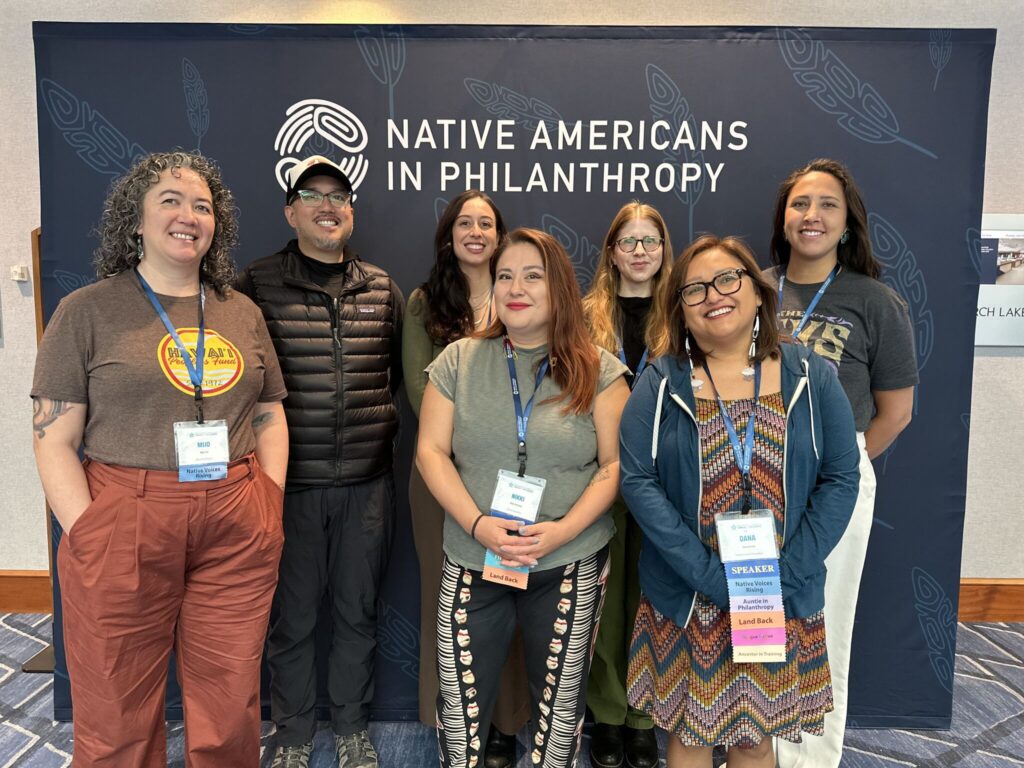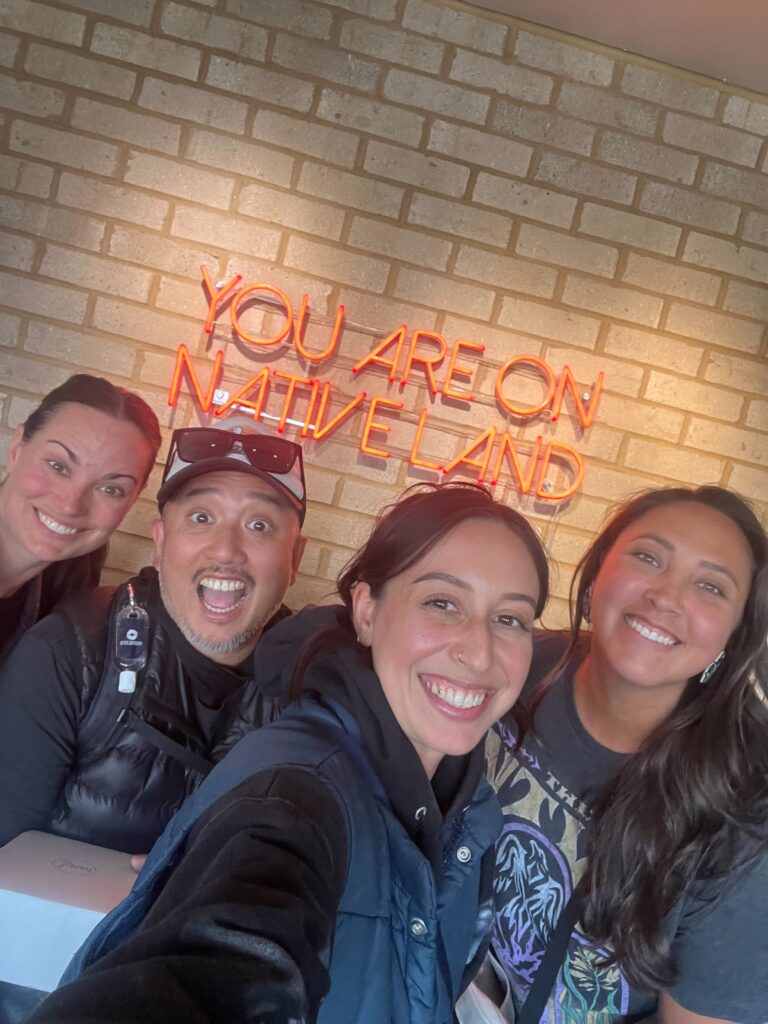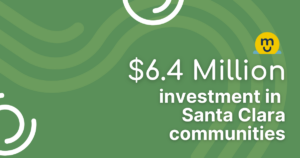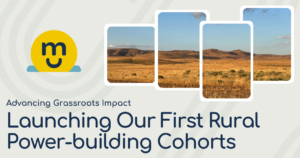Allow us to reintroduce ourselves as a learning organization.
Our approach is driven by community perspectives, rooted in reciprocity and trust, and focused on a major goal: organizing philanthropy to cede and share power with nonprofits. To realize this, we recognize that we have to first set this standard within our own work. For us, that means directly and deeply connecting with communities to understand emerging needs and shaping our grantmaking to be more responsive to those priorities.
As we began to explore funding in Native communities — a ‘new to us’ grantmaking area — we knew we needed to go one step further to understand the historical and current funding landscape and build trust with leaders and organizations already embedded in this space. This marked the first phase of our Native Partnerships work: showing up, listening, and learning to determine how we could best support Native communities.

Deepening connections with Native leaders and communities
After hosting a Listening Forum with Native nonprofit leaders in the San Francisco Bay Area (unceded territory of the Ohlone People), three members of our team took part in the Native Voices Rising Funder Learning Fellowship. The fellowship brought together 10 fellows representing six foundations to learn from and deepen relationships with Native leaders and experts.
Over six transformative months, we expanded our knowledge of Native communities and the philanthropic funding landscape across the country, learning from activists, organizers, and thought leaders about how to indigenize our philanthropy. We learned that as funders, we can and should start by:
- Recognizing Native intersectionality. The fellowship brought together thought leaders who spoke about how Native organizing, nonprofits, and philanthropy are uniquely intersectional. Not only do the same issues and conversations arise across fields, but so do the same people, organizations, and relationships.
- Investing in intermediaries. Because equitable and sincere relationships are central to Indigenous philanthropy and can take a long time to cultivate, investing in Native-led intermediaries is key. This approach is also helpful for Native-led nonprofits, as it takes the work of educating funders off the nonprofits.
- Commit to long-term funding. Funding to Native-led nonprofits and Native communities ebbs and flows with foundation interest. This has led to inconsistent and unreliable funding for communities that have been historically underinvested in by philanthropy. There’s long been a call for foundations to make funding in Native communities permanent commitments in their work.
- Building authentic relationships. The inherent power balance between foundations and nonprofits makes vulnerability a key part of establishing trusting relationships. It’s important for philanthropy to lead with humility and be willing to talk openly about money and power, not just for the benefit of Native communities but for all communities.
Not only did the fellowship offer a space for us to be in community with Native leaders and other non-Native funders, but it also helped us visualize a path forward for new and existing partnerships with Native-led organizations. While our team was eager to dive in and see how we could apply these learnings to our work, we also saw an opportunity to be more deeply engaged with funders who were resourcing and shifting power to Native communities.
Learning how to indigenize our philanthropy
In April 2024, our team traveled to Minneapolis (Mni Sota Makoce) for the 2024 Native Americans in Philanthropy Conference. Held over four days, the conference brought together a community of leaders, practitioners, and learners at the intersection of philanthropy, Native advocacy, and Tribal sovereignty to collaborate on indigenizing philanthropy.
During the conference, we heard from many Native leaders and philanthropic professionals about disrupting philanthropy’s status quo, amplifying Native-led solutions, and harnessing innovation to promote Indigenous perspectives. The conference also provided space for us to connect with members of our NVR Fellowship cohort.

Among the many insights shared at the conference, our team was surprised to learn that only 0.4% of private foundation funding goes to Native causes, and only half of those funds are allocated to Native-led nonprofits.* As a funder, it’s a stark reminder of our responsibility to equitably resource Native communities and trust them to fund the priorities they’ve identified as important. We also heard calls for philanthropy to explore and pursue:
- Reframing what it means to innovate. It’s important to reframe assumptions of what ‘innovation’ means in philanthropy, which tends to focus on experimentation. Innovation can also mean trusting community members to fund their priorities and lifting funding restrictions or eliminating reporting requirements.
- Increasing support to 501(c)4 organizations. At the conference, a number of attendees and speakers called for philanthropy to support advocacy work and spaces where Native communities engage in political dialogue. This helps Native communities engage with local and national elections to increase representation.
- Re-examining philanthropy’s fake rules. Fake rules are often presented as the unquestioned and unexamined best practices in philanthropy. These practices can create unnecessary barriers for communities and hold us back from transformational change. Some examples of these ‘fake rules’ include: grant applications with excessive questions, reporting requirements, regular site visits, and requests for financial documents.
Investing in Native-led, community-based funding pools. Increase support to Native community partners and intermediaries who often already have their own funding pools to redistribute unrestricted funds within their own communities.
…and these insights are just the tip of the iceberg. We’re excited to continue collaborating with Native-led organizations to build trust, uplift Indigenous values, and identify ways we can accelerate funding into Native communities. With that said, we’re sharing three reports that will continue to influence our Native Partnerships work:
On Our Terms: Supporting a Thriving Native Nonprofit Sector
Native Voices Rising: 10 Year Impact Report
Native Americans in Philanthropy: Tribal Nations Listening Session Report
*First Nations Development Institute, Growing Inequity: Large Foundation Giving to Native American Organizations and Causes 2006-2014



